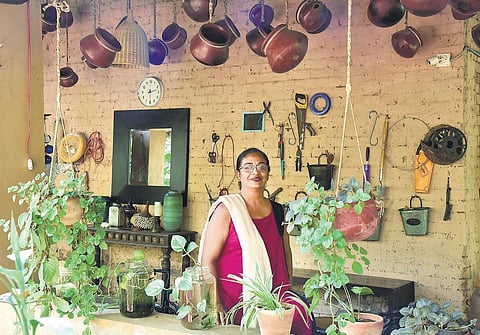

A variety of terracotta items line the shelves of the brick-walled hall—bottles, jars, vases, kettles, cups, mugs, lampshades, and what-have-you.
Outside, there are cottages for visitors who would like to stay and learn pottery.
A British couple is trying their hand at the potter’s wheel. “Mankind began their art through pottery. Pottery has been used for cooking, burial and storage. It has always been important for humans,” says Haseena Suresh, who set up the Clayfingers Pottery Studio at Urakam, Thrissur, along with her husband Suresh Subramanian 10 years ago.
Haseena’s interest in pottery goes back to her college days when she was pursuing her Master’s in sculpture from Santiniketan in West Bengal.
She moved to Dubai in 1998 with her husband. It was here that she took pottery lessons from a British artist.
On their many travels, the couple would always visit pottery studios in countries such as Italy, France, England, Germany and Canada. “I began to appreciate the beauty,” says Haseena, who was a panelist at the Talkathon titled, Life for Design, at the recent Kochi Design Week.
Inspired by the pioneering Japanese artist Shoji Hamada, Haseena wanted to bring his philosophy to India where pottery had long been regarded as only a practical craft.
The studio has been giving training to students from all over. “Lessons are provided to suit the individual, regardless of experience. Many have gone on to pick up studio pottery as a lifelong passion, or even professionally,” she says proudly.
The process to craft these pieces is simple: The clay is put in water for several days and is passed through a mesh to remove the impurities.
After that, it is poured onto a bed of Plaster of Paris and is then wedged and kneaded to make it more pliable. Thereafter, the mud is put out to dry. Finally, a potter’s wheel is used to mould.
After the basic design is formed, there is a curing time, as the item is put out in the sun. Then it is taken to the kiln, where firing takes place. Lastly, the surface is glazed.
As she designs a cup, Haseena says, “Pottery is like meditation. Your hands, eyes, and mind are focused. It is a centering of oneself. You return to earth through the mud. It is through concentration that the pot comes into being. I want to spread the beauty of this art form all over the world.”